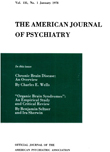HYSTERICAL PSYCHOSIS
Abstract
The term hysterical psychosis has been in common usage for longer than half a century, but it has never become part of the standard nomenclature. Indeed, there is no single article in the literature in which hysterical psychosis as an entity is described and the subject discussed. We have set down how the term is used to provide a fixed point of reference for support or criticism.
Our conceptualization of the process is essentially in agreement with Freud's formulation in his second article on the neuropsychoses insofar as we view the disturbance as a form of ego disruption. Descriptively, hysterical psychosis is marked by a sudden and dramatic onset temporally related to a profoundly upsetting event or circumstance. Its manifestations include hallucinations, delusions, depersonalization and grossly unusual behavior. Thought disorders, when they occur, are usually sharply circumscribed and very transient. Affectivity, if altered, is changed in the direction of volatility and not flatness. The acute episode seldom lasts longer than one to 3 weeks, and the eruption is sealed off so that there is practically no residue. Hysterical psychosis is encountered most commonly in persons referred to as hysterical characters or personalities when faced by trying life situations or problems.
Statements received from correspondents were consistent generally with our viewpoint. Case notes have been presented to illustrate certain aspects of the clinical picture.
Access content
To read the fulltext, please use one of the options below to sign in or purchase access.- Personal login
- Institutional Login
- Sign in via OpenAthens
- Register for access
-
Please login/register if you wish to pair your device and check access availability.
Not a subscriber?
PsychiatryOnline subscription options offer access to the DSM-5 library, books, journals, CME, and patient resources. This all-in-one virtual library provides psychiatrists and mental health professionals with key resources for diagnosis, treatment, research, and professional development.
Need more help? PsychiatryOnline Customer Service may be reached by emailing [email protected] or by calling 800-368-5777 (in the U.S.) or 703-907-7322 (outside the U.S.).



